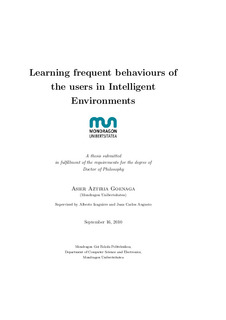
Ikusi/
Izenburua
Learning frequent behaviours of the users in intelligent environmentsEgilea
Irakurtze Data
2010-09-14Argitalpen data
2010Dokumentu-mota
Doktore tesiaDoktore tesiaHizkuntza
IngelesaEskubideak
© Asier Aztiria GoenagaSarbidea
Sarbide irekiaArgitaratzailearen bertsioa
https://doi.org/10.48764/5y93-6y86Argitaratzailea
Mondragon Unibertsitatea. Goi Eskola PoliteknikoaGako-hitzak
Inteligencia artificialSistemas de control del entorno
Laburpena
Intelligent Environments (IEs) are expected to support people in their daily lives. One of the hidden assumptions in IEs is that they propose a change ofu perspective in the relationships between huma ... [+]
Intelligent Environments (IEs) are expected to support people in their daily lives. One of the hidden assumptions in IEs is that they propose a change ofu perspective in the relationships between humans and technology, shifting from a techno-centered perspective to a human-centered one. Unlike current computing systems where the user has to learn how to use the technology, an IE adapts its behaviour to the user, even anticipating his/her needs, preferences or habits.
For that, the environment should learn how to react to the actions and needs of the users, and this should be achieved in an unobtrusive and transparent way. In order to provide personalized and adapted services, it is clear the need of knowing preferences and frequent habits of users. Thus, the ability to learn patterns of behaviour becomes an essential aspect for the successful implementation of IEs.
In that sense, a perfect learning system would gain knowledge about everything related to users that would help the environment act intelligently and proactively.
The efforts in this research work are focused on discovering frequent behaviours of the users. For that, it has been designed and developed the Learning Frequent Patterns of User Behaviour System (LFPUBS) that, taking into account all the particularities of IEs, learns frequent behaviours of the users.
The core of the LFPUBS is the Learning Layer that unlike some other components is independent of the particular environment in which the system is being applied. On the one hand, it includes a language that allows the representation of discovered behaviours in a clear and unambiguous way. On the other hand, coupled with the language, an algorithm that discovers frequent behaviours has been designed and implemented.
Finally, LFPUBS was validated using data collected from two real environments. Results obtained in such validation tests showed that LFPUBS was able to discover frequent behaviours of the users. Moreover, some improvements were identified for future versions of the system. [-]
Ingurune Adimentsuek bertan bizi diren pertsonei beren egunerokotasunean laguntzea dute helburu. Kontzeptu berri honek pertsona eta teknologiaren arteko erlazioan aldaketa bat dakarki berarekin, tekno ... [+]
Ingurune Adimentsuek bertan bizi diren pertsonei beren egunerokotasunean laguntzea dute helburu. Kontzeptu berri honek pertsona eta teknologiaren arteko erlazioan aldaketa bat dakarki berarekin, teknologiari garrantzia ematetik pertsonengan oinarritzera. Horrela, orain arteko sistemekin alderatuz, non pertsonek teknologia nola erabili ikasi behar duten, orain teknologia (ingurunea) bera da pertsonengana egokitu behar dena. Horretarako, inguruneak bertan dauden pertsonen behar, ohitura, etab. ezagutu behar ditu.
Jakintza guzti hori ordea, pertsonak inondik inora gogaitu gabe lortu behar du inguruneak. Pertsona bakoitzari dagozkion edo nahi dituen zerbitzuak emateko inguruneak pertsona horren ohiko jokabideak jakitea behar du. Orduan, ingurune horrek ikasketa prozesu bat jarraitu behar du, non, pertsona horien ohiko jokabideak era automatiko eta garden batean lortuko dituen.
Ikerketa lan honen helburua horixe izan da, ingurune adimentsu bateko pertsonen ohiko jokabideak era automatiko eta garden batean deskubrituko dituen sistema bat dise˜natu eta garatzea. Gainera, garatutako sistema horrek, Learning Frequent Patterns of User Behaviour System (LFPUBS), ingurune adimentsuen berezitasun guztiak hartzen ditu kontutan.
LFPUBS-en barruan berebiziko garrantzia du Ikasketako geruzak, zein ez dagoen sistema aplikatzen ari den ingurunearen menpe. Geruza horretan bi osagaik merezi dute aparteko aipamena, alde batetik, ikasitako jakintza era garbi batean adieraztea ahalbidetzen duen hizkuntzak, eta beste alde batetik, jakintza bera deskubritzen duen algoritmoak.
Azkenik, esan beharra dago LFPUBS balioztatua izan dela benetako bi ingurune adimentsuetan jasotako datuekin. Lortutako emaitzek garbi adierazten dute LFPUBS-ren gaitasuna ohiko jokabideak deskubritzeko garaian. Gainera, emaitzen analisi sakon batek LFPUBS-ri buruzko hobekuntzak argitaratzeko balio izan du. [-]
Los Entornos Inteligentes (EIs) tratan de facilitar las actividades diarias a las personas que se encuentran en él. El concepto de Entornos Inteligentes supone un cambio radical en las relaciones entr ... [+]
Los Entornos Inteligentes (EIs) tratan de facilitar las actividades diarias a las personas que se encuentran en él. El concepto de Entornos Inteligentes supone un cambio radical en las relaciones entre los usuarios y la tecnología. El cambio consiste en que se pasa desde una perspectiva centrada en la tecnología a una perspectiva centrada en el usuario. A diferencia de los sistemas actuales donde el usuario se tiene que adaptar a la tecnología, ahora, esta es la que se adapta a las preferencias, costumbres o gustos del usuario.
Los entornos inteligentes deberán aprender cuáles son los comportamientos frecuentes de los usuarios para así adaptarse a los usuarios y proveer servicios personalizados. De este modo, la capacidad de aprendizaje se convierte en un requisito indispensable para dichos entornos.
El objetivo de este trabajo de investigación es desarrollar un sistema que aprenda de forma automática, los comportamientos frecuentes de los usuarios de entornos inteligentes. Para ello, se ha diseñado y desarrollado el Learning Frequent Patterns of User Behaviour System (LFPUBS), que teniendo en cuenta todas las particularidades de dichos entornos, descubre tales comportamientos.
El núcleo del LFPUBS es la capa de Aprendizaje que a diferencia de otros componentes es independiente del entorno donde está siendo aplicado el sistema.
Dicha capa, por un lado incluye un lenguaje que permite representar los patrones de una forma clara y no ambigua y por otro, en concordancia con el lenguaje, incluye el algoritmo que descubre dichos patrones.
Finalmente, LFPUBS ha sido validado utilizando los datos recogidos en dos entornos inteligentes reales. Los resultados obtenidos durante esos experimentos permitieron comprobar que LFPUBS es capaz de descubrir los comportamientos frecuentes de los usuarios. Además, mejoras para futuras versiones del sistema fueron identificadas. [-]
Bildumak
- Tesiak - Ingeniaritza [243]




















